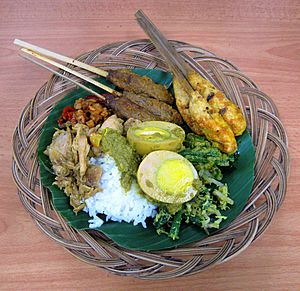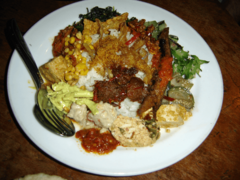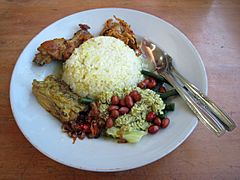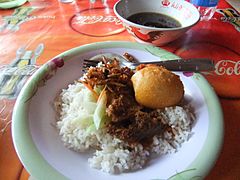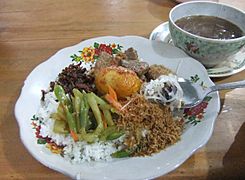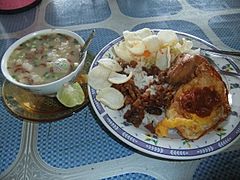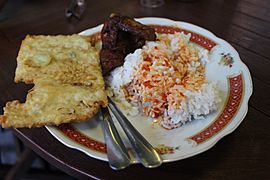Nasi campur facts for kids
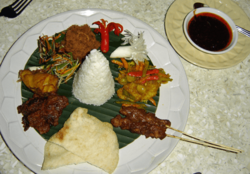
|
|
| Alternative names | Nasi rames |
|---|---|
| Course | Main course |
| Place of origin | Indonesia |
| Region or state | Maritime Southeast Asia |
| Associated national cuisine | Indonesia |
| Serving temperature | Hot or room temperature |
| Main ingredients | Rice with various side dishes |
| Variations | Nasi Campur Bali, Nasi Rames (Indo) |
| Other information | Also popular in the Netherlands |
Nasi campur is an Indonesian dish that means 'mixed rice'. It is also known as nasi rames or sega campur in Java. This tasty meal usually has a scoop of white rice. It comes with small amounts of other dishes. These can include meats, vegetables, peanuts, eggs, and fried shrimp crackers called krupuk.
Nasi campur is a very popular meal in Indonesia. You can also find it in Malaysia, Singapore, Brunei, and southern Thailand. It is even popular in the Netherlands because of Indonesia's history with that country. A similar dish called chanpurū is found in Okinawa.
Contents
What is Nasi Campur?
Nasi campur is a very common dish all over Indonesia. There are many different kinds, just like the many islands of Indonesia. There isn't one exact recipe for nasi campur. This is because people in Indonesia and Southeast Asia often eat steamed rice with many side dishes. These side dishes can be vegetables and meat.
Nasi campur is usually seen as steamed rice served with different dishes. These are served in portions for one person. This is different from a tumpeng, which is a cone-shaped rice dish served for many people at once.
Different Kinds of Nasi Campur
You can find several local versions of nasi campur. These include types from Java, Bali, the Malay Peninsula, Borneo, and Sulawesi. There are also versions made by people of Indonesian and European heritage, and by Chinese Indonesians. A similar dish from the Minangkabau people is called nasi Padang. This is very popular in the Sumatra region.
Balinese Nasi Campur
In Bali, the mixed rice is called nasi campur Bali or simply nasi Bali. It is a favorite for visitors to the island. This Balinese version is probably the most famous around the world. This is because Bali is a very popular island for tourists.
The flavors in Balinese nasi campur are very special. They often use basa genep, which is a unique Balinese spice mix. This spice mix is used in many curry and vegetable dishes. A Balinese mixed rice might have grilled tuna, fried tofu, cucumber, spinach, tempeh, beef cubes, vegetable curry, corn, and chili sauce. All of this is served on a bed of rice. Street vendors often sell mixed rice wrapped in a banana leaf.
Bali is an island where most people follow the Hindu religion. So, the Balinese version might include lawar (a mix of vegetables, coconut, and meat) and babi guling (roast pork). But you can also find halal versions. These versions use chicken dishes like ayam betutu, sate lilit (minced meat satay), and eggs instead.
Javanese Nasi Campur
In Java, nasi campur is often called nasi rames. You can find many different kinds of it across the island. One dish often found in Javanese nasi campur is fried noodles.
The dish known as nasi rames was created in West Java during World War II. It was made by Truus van der Capellen, a cook of Indonesian and European background. She ran soup kitchens in Bandung during and after the Japanese occupation. Later, she opened a restaurant in the Netherlands. This made the dish popular there too.
In Yogyakarta, a Javanese nasi campur is called nasi ingkung. This special meal includes a whole cooked chicken dish called ayam ingkung. It also has urapan kasultan (mixed vegetables with coconut), perkedel (fried patties), empal gapit (sweet fried beef), sate tusuk jiwo (meat skewers), and tumpeng rice.
Chinese Indonesian Nasi Campur

In cities like Jakarta, where many Chinese people live, the term nasi campur can mean something different. It often refers to nasi campur Tionghoa, which is a Chinese-style mixed rice. This dish has rice with different kinds of barbecued meats. These can include char siew (barbecued pork), crispy roast pork, sweet pork sausage, and pork satay.
This Chinese-style nasi campur usually comes with a simple Chinese chicken soup. Sometimes it's served with sayur asin, which is a clear soup made from pork bones and fermented mustard greens. This specific dish name is mostly used in Jakarta. It is not common in mainland China, Singapore, Malaysia, or most other parts of Indonesia.
Nasi Campur Today
The name nasi campur Tionghoa is a shorter way to say "rice with a mix of Chinese-style meats." Often, Chinese food stalls serve only one type of meat with rice and soup. If you want different meats, you usually order them separately. So, nasi campur Tionghoa is like a combo meal with various Chinese barbecued meats.
Most of the time, when people say "nasi campur," they mean the Indonesian and Malaysian versions. These are rice served with many different side dishes. In Indonesia, it means any kind of rice surrounded by various dishes. In Malaysia, it usually means Malay mixed rice.
In countries like Japan, the United States, and many others, nasi campur often refers to the Balinese version. But in the Netherlands, it usually means the Indo-colonial nasi rames. The side dishes can be very different depending on the region and the restaurant.
Gallery
-
Nasi campur served in Jeneponto, South Sulawesi
-
Javanese nasi campur with honey chicken and tempeh
See also
 In Spanish: Nasi campur para niños
In Spanish: Nasi campur para niños


